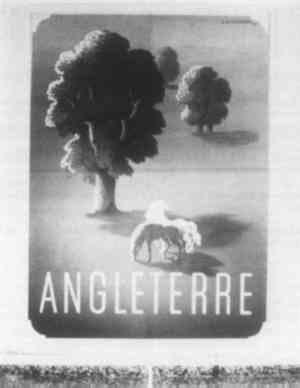TREATMENT AND MOUNTING OF A POSTER ANGLETERRE BY A.M. CASSANDREAntoinette Owen
5 MOUNTING THE POSTERTHE POSTER WAS ORIGINALLY INTENDED to be viewed mounted and flat. In keeping with this intention it was decided to mount the quadrants onto a ragboard-surfaced aluminum Hexcel panel. The panel was built to be several inches larger in each dimension than the assembled poster. Several sheets of oversize ragboard, bevel-cut at joins to eliminate uneveness and effect a continuous surface, were attached to one side of the aluminum panel with Beva 371. The ragboard surface was then given a light and even spray of Beva 371 in toluene. The spray was applied under high pressure, which helped to create, along with the rapid evaporation of the toluene, a spider web or flocked layer of adhesive on the ragboard surface. It was felt that this method of application enabled a type of nap bonding to take place between the Usugami tissue and the ragboard. The vacuum hot table was used to attach the poster to the panel; only minimum heat (140�F) and pressure were necessary. The pulp fills were toned with Liquitex acrylic paint. This paint, though not reversible, simulates lithographic inks very well. Toning of the tears and other original paper surfaces such as abrasions was accomplished with Winsor & Newton watercolors and Grumbacher pastels. The poster was displayed in an Art Deco poster exhibition soon after treatment was completed (Fig. 8). Although the aluminum panel was probably the lightest rigid support possible, the additional weight of a wooden frame and �-inch Plexiglas created a very heavy package. Therefore, the Plexiglas was attached in such a way that it can be removed from the frame and panel during storage. The poster is stored on a steel rack in the painting storage area of the Hirshhorn Museum.
|
